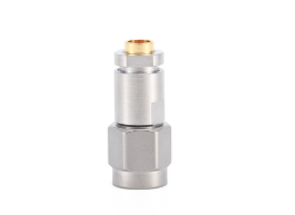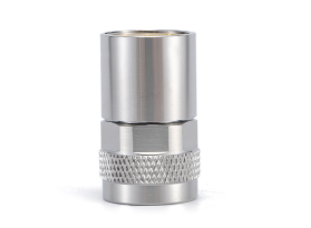Analysis of the causes of failure of Micro RF Coaxial Connectors and solutions
 Feb 21, 2022|
Feb 21, 2022| View:509
View:509Each Micro RF Coaxial Connectors has a rated life cycle, the inner conductor of the connector is smaller in size compared to the outer conductor, and the poorer strength of the inner conductor is more likely to cause poor contact and cause Micro RF Coaxial Connectors to fail.
Most of the Micro RF Coaxial Connectors inner conductors use elastic connection methods, such as: spring claw type elastic connection, jack slotted elastic connection, bellows type elastic connection. Among them, the jack slotted elastic connection structure is simple, low processing costs, assembly is more convenient, the most widely used. In the use of connectors pay attention to the following matters, you can also improve or avoid some problems.

The inner conductor is not fixed firmly
For assembly needs, many RF coaxial connectors (e.g. N type, 3.5mm) are constructed by splitting the inner conductor into two parts at the dielectric support and then connecting them by thread. However, due to the small diameter of the internal conductor, if the threaded connection is not secured during assembly to hold the internal connection in place, the strength of the internal conductor connection will be very poor, especially for some Micro RF Coaxial Connectors. As a result, when the connector is connected and disconnected multiple times, the threads of the inner conductor may loosen and come off under prolonged torque and tension, resulting in a failed connection.
One of the common constructions of Micro RF Coaxial Connectors is that the inner conductor, the dielectric holder and the outer conductor are held together by an adhesive. In this structure, if the amount of adhesive applied during the assembly process is insufficient or the adhesive does not have sufficient connection strength, the adhesive may break during use due to the force, which will cause the inner conductor to rotate or move axially, fail to form good electrical contact with the inner conductor, and the connection will fail.
Solution: When assembling the coaxial connector, apply an appropriate amount of conductive adhesive or thread locker to the threaded connection to improve the reliability of the threaded connection. Adhesive with higher bonding strength should be selected and must be used to fill the entire adhesive hole when applying adhesive; knurling on the inner conductor adhesive to increase the contact area between the inner conductor and the adhesive to prevent the inner conductor from rotating; properly adjusting the radial dimensions and tolerances of the inner conductor conductor, outer conductor and dielectric holder to make a tight fit between the inner conductor and the dielectric holder, and the interference between the dielectric holder and the outer conductor The fit also creates an interference fit between the inner conductor and the outer conductor. The three assemblies are stronger together.
Incorrect size of the jack or pin of the inner conductor
If the hole diameter of the conductor in the jack is smaller than the specified size, the jack will over-expand when the pin of the conductor in the jack enters the jack, and the deformation will exceed its elastic deformation range, resulting in plastic deformation and causing damage to the conductor in the jack; conversely, if the diameter of the pin is too small, when the pin and the socket are matched, the gap between the pin and the wall of the socket is too large, and the two inner conductors of the connector cannot closely contact. If the contact resistance becomes large, the electrical performance index will also be poor.
Solution: The reasonableness of the fit of the socket and the pin can be measured by the insertion force and holding force of the conductor in the standard gauge pin and socket. For N type connector, the insertion force should be ≤ 9N when the diameter Φ1.6760+ 0.005 standard gauge pin matches with the socket, and the holding force ≥ 0.56 N when the diameter Φ1.6000-0.005 standard gauge pin matches with the conductor in the socket Therefore, we can use the insertion force and holding force as the test standard. By adjusting the size and tolerance of the jack and pin and the aging process of the conductor in the jack, the insertion and retention forces between the pin and the jack can be adjusted to stay within the proper range.
Micro RF Coaxial Connectors
About Micro RF Coaxial Connectors caused by the failure of some factors or worthy of attention, the following points are common causes of connector failure.
1.Micro RF Coaxial Connectors degree of wear and tear
Micro RF Coaxial Connectors repeated connection and disconnection will lead to the contacts on the metal in the exposure to water, dust, dirt and other irritating elements wear and corrosion, so that the mating pin in the connector shell may not be properly engaged.
2. Micro RF Coaxial Connectors improper selection
The choice of Micro RF Coaxial Connectors products if the size or specifications are not appropriate, not only will reduce the efficiency of use, but also shorten the life of the connector.
3. Micro RF Coaxial Connectors application temperature
If Micro RF Coaxial Connectors are not rated for high or low temperatures, they will eventually fail, because Micro RF Coaxial Connectors are not suitable for high temperatures, then insulation failure and peak conductivity. If operated at consistently high temperatures, these spikes will increase the temperature and may lead to corrosion and ultimately reduced contact force. This can affect the electrical signals that propagate through the connector and cable assembly.
While cold temperatures will not affect connectors as severely as high temperatures, consider low temperature designs if the application demands it. Applying connectors at consistently low temperatures, as in the case of a connector, can cause the tinned connector material to soften, thereby increasing contact resistance. In addition, the low temperature will affect other parts of the connector, such as making the plastic shell brittle.
4. Micro RF Coaxial Connectors improper design and installation
If the application of Micro RF Coaxial Connectors will encounter shock, vibration and other destructive factors, those who can produce a strong latch safety design is very important. If not securely installed, connector contacts, mating shells and even cables can suffer damage.

In summary, Micro RF Coaxial Connectors and cable assemblies must have proper strain relief and mounting wiring, and the use of guide grooves, cable brackets and cable sealing sleeves can help ensure a rated connector assembly life.




